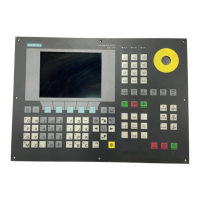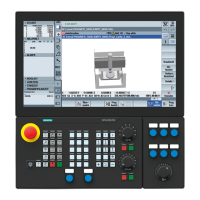V1: Feedrates
17.4 Feedrate control
Basic Functions
1408 Function Manual, 09/2011, 6FC5397-0BP40-2BA0
Examples:
end-of-motion criterion for single axes
Similar to the block change criterion for path interpolation (G601,G602, G603) the end-of-motion criterion for
traversing motion of individual axes can be programmed in part programs/synchronized actions:
The most recently programmed value is kept after the end of program or NC-RESET.
The effective end-of-motion criterion can be read using the axis-specific system variable $AA_MOTEND.
Writing ACC in a part program:
N80 G01 POS[X]=100 FA[X]=1000 ACC[X]=90 IPOENDA[X]
Writing ACC in a synchronized action:
N100 EVERY $A_IN[1] DO POS[X]=50 FA[X]=2000 ACC[X]=140 IPOENDA[X]
Writing ACC and reading $AA_ACC in a part program:
ACC[X]=50 ; writing
RO=$AA_ACC[X] ; reading
IF (RO <> $MA_MAX_AX_ACCEL[X] * 0.5) ; checking
SETAL(61000)
ENDIF
Writing ACC and reading $AA_ACC in a synchronized action:
WHEN TRUE DO ACC[X]=25 R0=$AA_ACC[X] ; writing and reading
G4 F1
IF (RO <> $MA_ MAX_AX_ACCEL[X] * 0.25) ; checking
SETAL(61001)
ENDIF
Program command End-of-motion criterion
FINEA[<axis>]
"Exact stop fine"
COARSEA[<axis>]
"Exact stop coarse"
IPOENDA[<axis>]
"Interpolator stop" (IPO stop)
Note
Depending on whether the system variable $AA_MOTEND is read in the part program or
synchronized action, it contains the value for the NC axes or the main-run axes.

